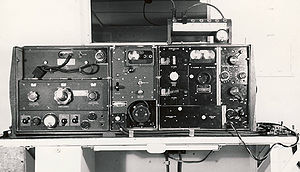Wireless Set Canadian No. 9
| Wireless Set Canadian No. 9 | |
|---|---|
 Wireless Set Canadian No 9 | |
| Specifications | |
| Weight | 192 lbs |
| Length | 41” |
| Width | 12” |
| Height | 16” |
| | |
| Frequency range |
1.875-5 MHz |
| Power output |
5/10W |
| Range | up to 35 miles |
The Wireless set No.9 was developed in the mid 1930s to replace the unsuccessful tank sets then in use. It was used throughout the early war years and was very reliable, though suffering from limited frequency range. Difficult to mass produce, British production ceased after 4000 sets were built. Canadian production continued until 1942 with an estimated number of less than 500 sets.
The set consists of a receiver on the left, a rotary transformer power unit in the centre and a sender on the right. The three units arere held in an aluminum shock mounted carrier that has plugs to connect the units along its top back. Complete, it is 41” wide by 16” tall by 12” deep and weighs 192 lbs. It operats R/T (voice), CW and MCW (morse) and its AM frequency coverage is 1.875 to 5 MHz with a range of 10 miles (voice) up to 35 miles (CW) using a standard 6’ aerial. Different aerials can be used to increase range and these can be located some distance away from the set when an ‘Aerial Coupling Equipment B’ is used. Volt and ammeters are plug in so they can be easily replaced and access to the sender valves is through doors on the set’s face. The set can be tuned to and switched between two channels, A and B, colour coded red and blue so the operator could keep track of them. Like the Wireless Set No. 11, switching between ‘send’ and ‘receive’ is accomplished by manually moving a large plastic knob on the supply unit. Power to the set is 12 volts typically provided by pairs of 6 volt lead acid batteries.[1]
Canadians further developed the No.9 set into an improved Wireless Set Canadian No. 9 Mk I in 1943 which itself was further developed into the very successful Wireless Set No. 52 of 1944.
Related Pages
Related Items
References
- ↑ Information from Bruce Parker




